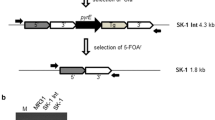Abstract
A well-functioning genetic system, which is important for studying gene functions in vivo, requires a transformation method, a vector system and a selection system. Sulfolobus acidocaldarius is a crenarchaeal model organism that grows optimally at 75 °C and a pH of 3. These extreme growth conditions cause some difficulties in developing a genetic system. With continuous efforts, versatile genetic tools have been developed for different species from the order of Sulfolobales. In this chapter, we describe the methods for the available genetic tools in S. acidocaldarius including a (1) transformation method, (2) pop in/pop out strategy to generate markerless deletion mutants and (3) a plasmid-based expression system.
Access this chapter
Tax calculation will be finalised at checkout
Purchases are for personal use only
Similar content being viewed by others
References
Lewis AM, Recalde A, Bräsen C, Counts JA, Nussbaum P, Bost J, Schocke L, Shen L, Willard DJ, Quax TEF (2021) The biology of thermoacidophilic archaea from the order Sulfolobales. FEMS Microbiol Rev 45(4):fuaa063
Albers S-V, Driessen AJM (2008) Conditions for gene disruption by homologous recombination of exogenous DNA into the Sulfolobus solfataricus genome. Archaea 2:145–149
Kurosawa N, Grogan DW (2005) Homologous recombination of exogenous DNA with the Sulfolobus acidocaldarius genome: properties and uses. FEMS Microbiol Lett 253:141–149
Berkner S, Grogan D, Albers S-V, Lipps G (2007) Small multicopy, non-integrative shuttle vectors based on the plasmid pRN1 for Sulfolobus acidocaldarius and Sulfolobus solfataricus, model organisms of the (cren-) archaea. Nucleic Acids Res 35:e88
Prangishvili D, Stedman K, Zillig W (2001) Viruses of the extremely thermophilic archaeon Sulfolobus. Trends Microbiol 9:39–43
Snyder JC, Stedman K, Rice G, Wiedenheft B, Spuhler J, Young MJ (2003) Viruses of hyperthermophilic archaea. Res Microbiol 154:474–482
Prangishvili D, Garrett RA (2004) Exceptionally diverse morphotypes and genomes of crenarchaeal hyperthermophilic viruses. Biochem Soc Trans 32:204–208
Lipps G (2006) Plasmids and viruses of the thermoacidophilic crenarchaeote Sulfolobus. Extremophiles 10:17–28
Deng L, Zhu H, Chen Z, Liang YX, She Q (2009) Unmarked gene deletion and host–vector system for the hyperthermophilic crenarchaeon Sulfolobus islandicus. Extremophiles 13:735
Keeling PJ, Klenk H-P, Singh RK, Feeley O, Schleper C, Zillig W, Doolittle WF, Sensen CW (1996) Complete nucleotide sequence of the Sulfolobus islandicus multicopy plasmid pRN1. Plasmid 35:141–144
Keeling PJ, Klenk H-P, Singh RK, Schenk ME, Sensen CW, Zillig W, Doolittle WF (1998) Sulfolobus islandicus plasmids pRN1 and pRN2 share distant but common evolutionary ancestry. Extremophiles 2:391–393
Li Y, Pan S, Zhang Y, Ren M, Feng M, Peng N, Chen L, Liang YX, She Q (2016) Harnessing type I and type III CRISPR-Cas systems for genome editing. Nucleic Acids Res 44:e34–e34
Zebec Z, Manica A, Zhang J, White MF, Schleper C (2014) CRISPR-mediated targeted mRNA degradation in the archaeon Sulfolobus solfataricus. Nucleic Acids Res 42:5280–5288
Wagner M, van Wolferen M, Wagner A, Lassak K, Meyer BH, Reimann J, Albers S-V (2012) Versatile genetic tool box for the Crenarchaeote Sulfolobus acidocaldarius. Front Microbiol 3:214
Zhang C, Cooper TE, Krause DJ, Whitaker RJ (2013) Augmenting the genetic toolbox for Sulfolobus islandicus with a stringent positive selectable marker for agmatine prototrophy. Appl Environ Microbiol 79:5539–5549
Van Der Kolk N, Wagner A, Wagner M, Waßmer B, Siebers B, Albers S-V (2020) Identification of XylR, the activator of arabinose/xylose inducible regulon in Sulfolobus acidocaldarius and its application for homologous protein expression. Front Microbiol 11:1066
Moll R, Schäfer G (1988) Chemiosmotic H+ cycling across the plasma membrane of the thermoacidophilic archaebacterium Sulfolobus acidocaldarius. FEBS Lett 232:359–363. https://doi.org/10.1016/0014-5793(88)80769-5
Brock TD, Brock KM, Belly RT, Weiss RL (1972) Sulfolobus: a new genus of sulfur-oxidizing bacteria living at low pH and high temperature. Arch Mikrobiol 84:54–68
Prangishvili DA, Vashakidze RP, Chelidze MG, Gabriadze IY (1985) A restriction endonuclease SuaI from the thermoacidophilic archaebacterium Sulfolobus acidocaldarius. FEBS Lett 192:57–60. https://doi.org/10.1016/0014-5793(85)80042-9
Acknowledgements
We are grateful to all the bachelor’s, master’s, and PhD students; technicians; and postdoctoral researchers who helped developing and optimizing the genetic system for Sulfolobus acidocaldarius throughout the years, especially Michaela Wagner and Alexander Wagner. MvW received support from the Momentum grant 94933 from the Volkswagen Foundation. XY was funded by the Life? Grant Az 96727 from the Volkswagen Foundation, and AR received support from the HotAcidFactory grant 031B0848C from the BMBF (Federal Ministry of Education and Research).
Author information
Authors and Affiliations
Corresponding authors
Editor information
Editors and Affiliations
Rights and permissions
Copyright information
© 2022 The Author(s), under exclusive license to Springer Science+Business Media, LLC, part of Springer Nature
About this protocol
Cite this protocol
Ye, X., Recalde, A., Albers, SV., van Wolferen, M. (2022). Methods for Markerless Gene Deletion and Plasmid-Based Expression in Sulfolobus acidocaldarius. In: Ferreira-Cerca, S. (eds) Archaea. Methods in Molecular Biology, vol 2522. Humana, New York, NY. https://doi.org/10.1007/978-1-0716-2445-6_8
Download citation
DOI: https://doi.org/10.1007/978-1-0716-2445-6_8
Published:
Publisher Name: Humana, New York, NY
Print ISBN: 978-1-0716-2444-9
Online ISBN: 978-1-0716-2445-6
eBook Packages: Springer Protocols




